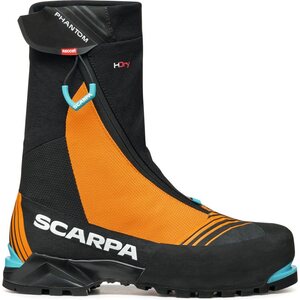(82,80 €, 付加価値税 0)

For those already familiar with climbing, transitioning to ice climbing only requires the right gear and a willingness to try something new. Ice climbing is also suitable for beginners, especially if you can convince a more experienced ice climber to accompany you to the waterfalls. You can also try ice climbing through guided courses offered by climbing guides and clubs.
Perhaps the most famous and best ice climbing waterfalls in Finland are located in the Korouoma Nature Reserve in Posio. In addition, there are ice falls suitable for climbing in various locations around Finland, although the formation and climbability of the falls can vary from winter to winter. It's a good idea to ask local climbing clubs for recommendations on suitable climbing spots.
For safety reasons, it's best to start ice climbing with a top rope. You can set up a top rope at the waterfall using familiar rock climbing techniques, such as anchoring to a tree. Experienced ice climbers may also create a suitable anchor for top-roping using ice screws. In addition to a rope and anchor equipment, ice climbing with a top rope requires personal climbing gear such as a harness and a helmet. An ATC is a suitable belay device. Climbers who already practice rope climbing likely have these items at home.

(82,80 €, 付加価値税 0)
(60,04 €, 付加価値税 0)
(87,46 €, 付加価値税 0)
(74,02 €, 付加価値税 0)
For ice climbing, you’ll also need ice climbing-specific crampons and ice climbing boots to attach the crampons to. Additionally, climbers will need ice axes for their hands.
While you can get some ice climbing advice in advance, the best way to learn is by heading to the icefall and practicing on the wall.
As a general rule, you swing the ice axes from around the level of your ear, with the swing resembling more of a whipping motion rather than hammering. There’s no need to grip the axes too tightly; a slightly looser grip often makes it easier to sink the axes into the ice, preventing early hand fatigue.
When climbing, keep your hips and center of gravity as close to the wall as possible. When striking with the axes, it helps to lean your upper back slightly backward to make it easier to use the axes. If your hands start to get cold while climbing, shake them below your heart to improve blood circulation.
The front of the crampons has one or two sharp points, depending on the model, and it’s essential to kick them securely into the wall. Like in all types of climbing, try to keep as much of your weight on your legs as possible and use your legs’ strong muscles to ascend.
When striking with the ice axes, small or large chunks often break off. A helmet visor can help protect your face from flying ice, or you can wear separate protective goggles. Pay attention to where you strike the ice; you can often tell if a piece of ice is about to break just by looking at it.
If the ice around the axe starts to break away, the axe may not hold much weight, and it’s better to re-swing the axe into the ice. Belayers should stay extra alert during ice climbing and watch out for falling chunks of ice from above. Due to the falling ice, helmets are essential for both the climber and the belayer.
As you progress in ice climbing, you can slowly transition from top-roping to leading on ice. Ice leading should be approached with respect, as falling while ice leading is much more dangerous than falling during sport climbing or trad climbing. That's why the essential rule for ice leading is "don’t fall."
If you’re interested in ice leading, it’s best to learn the sport by taking a course or with the help of an experienced ice climbing guide. This way, you can learn the proper use of ice screws safely.
HELP WITH BUYING ICE CLIMBING GEAR
Ice Climbing Boots and Crampons:
Crampons can sometimes be attached to ski boots or stiff hiking boots, but you’ll generally get better results with dedicated ice climbing or mountaineering boots.

(469,51 €, 付加価値税 0)
(529,02 €, 付加価値税 0)
(366,25 €, 付加価値税 0)
(422,50 €, 付加価値税 0)
If possible, it’s a good idea to try on ice climbing boots in-store to ensure a good fit for your feet.
Automatic crampons require special front and rear points on the boots to lock the metal attachments, while semi-automatic crampons have a rubber and strap attachment at the front, so the boots don’t necessarily need to have a front point for crampons. Both automatic and semi-automatic crampons are suitable for ice climbing.
Ice climbing crampons come with one or two front points, or sometimes one large and one small point. All options work well, and the choice is largely a matter of personal preference.

(139,60 €, 付加価値税 0)
(178,42 €, 付加価値税 0)
(145,98 €, 付加価値税 0)
(155,98 €, 付加価値税 0)
Ice Axes:
Axes suitable for ice climbing are sturdier than axes used for mountaineering. Ice axes for technical climbing typically have a curved shaft and two handles. The double handles make it easier to grab the axe on the wall with both hands, facilitating hand switches. If you want to use your axes for dry tooling as well, choose a technical ice axe. Ice axes suitable for ice climbing that are a bit more versatile have a shaft that’s not as curved and may lack the second handle.

(180,13 €, 付加価値税 0)
(158,00 €, 付加価値税 0)
(197,36 €, 付加価値税 0)
(175,60 €, 付加価値税 0)